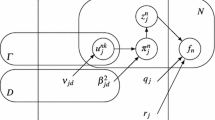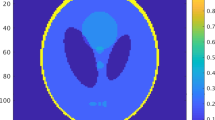Abstract
We present a Bayesian joint mixture framework for integrating anatomical image intensity and region segmentation information into emission tomographic reconstruction in medical imaging. The joint mixture framework is particularly well suited for this problem and allows us to integrate additional available information such as anatomical region segmentation information into the Bayesian model. Since this information is independently available as opposed to being estimated, it acts as a good constraint on the joint mixture model. After specifying the joint mixture model, we combine it with the standard emission tomographic likelihood. The Bayesian posterior is a combination of this likelihood and the joint mixture prior. Since well known EM algorithms separately exist for both the emission tomography (ET) likelihood and the joint mixture prior, we have designed a novel EM2 algorithm that comprises two EM algorithms—one for the likelihood and one for the prior. Despite being dove-tailed in this manner, the resulting EM2 algorithm is an alternating descent algorithm that is guaranteed to converge to a local minimum of the negative log Bayesian posterior. Results are shown on synthetic images with bias/variance plots used to gauge performance. The EM2 algorithm resulting from the joint mixture framework has the best bias/variance performance when compared with six other closely related algorithms that incorporate anatomical information to varying degrees.
Similar content being viewed by others
References
B.A. Ardekani, M. Braun, B.F. Hutton, I. Kanno, and H. Ida, “Minimum cross-entropy reconstruction of PET images using prior anatomical information,” Phys. Med. Biol., Vol. 41, No. 11, pp. 2497-2517, 1996.
J. Bernardo and A. Smith, Bayesian Theory, John Wiley and Sons: New York, NY, 1994.
J.E. Bowsher, V.E. Johnson, T.G. Turkington, R.J. Jaszczak, and C.E. Floyd, Jr., “Bayesian reconstruction and use of anatomical a priori information for emission tomography,” IEEE Trans. Med. Imag., Vol. 15, No. 5, pp. 673-686, 1996.
V. de Sa and D. Ballard, “Category learning through multimodality sensing,” Neural Computation, Vol. 10, No. 5, pp. 1097-1118, 1998.
A.P. Dempster, N.M. Laird, and D.B. Rubin, “Maximum likelihood from incomplete data via the EM algorithm,” J. R. Statist. Soc. Ser. B, Vol. 39, pp. 1-38, 1977.
G. Gindi, M. Lee, A. Rangarajan, and I.G. Zubal, “Bayesian reconstruction of functional images using anatomical information as priors,” IEEE Trans. Med. Imag., Vol. 12, No. 4, pp. 670-680, 1993.
S. Gold, A. Rangarajan, and E. Mjolsness, “Learning with preknowledge: Clustering with point and graph matching distance measures,” Neural Computation, Vol. 8, No. 4, pp. 787-804, 1996.
R. Hathaway, “Another interpretation of the EM algorithm for mixture distribution,” Statistics and Probability Letters, Vol. 4, pp. 53-56, 1986.
T. Hebert and R. Leahy, “A generalized EM algorithm for 3-D Bayesian reconstruction for Poisson date using Gibbs priors,” IEEE Trans. Medical Imaging, Vol. 8, No. 2, pp. 194-202, 1989.
C.H. Hsu and R. Leahy, “PET image reconstruction incorporating anatomical information using segmented regression,” in Proc. SPIE Vol. 3034: Medical Imaging-Image Processing, Newport Beach, CA, 1997, K. Hanson (Ed.), SPIE, pp. 381-392.
R. Leahy and X. Yan, “Incorporation of anatomical MR data for improved functional imaging with PET,” in Information Processing in Medical Imaging, D. Ortendahl and J. Llacer (Eds.), Wiley-Liss, 1991, pp. 105-120.
S. Lee, I. Hsiao, and G. Gindi, “The thin plate as a regularizer in Bayesian SPECT reconstruction,” IEEE Trans Nucl. Sci., Vol. 44, No. 3, pp. 1381-1387, 1997.
B. Lipinski, H. Herzog, E. Roat Kops, W. Oberschelp, and H.W. Muller-Gartner, “Expectation-maximization reconstruction of positron emission tomography images using anatomical magnetic resonance information,” IEEE Trans. Med. Imag., Vol. 16, No. 2, pp. 129-136, 1997.
G.J. McLachlan and K.E. Basford, Mixture Models: Inference and Applications to Clustering, Marcel Dekker: New York, 1988.
C.C. Meltzer, J.P. Leal, H.S. Mayberg, H.N. Wagner, Jr., and J.J. Frost, “Correction of PET data for partial volume effects in human cerebral cortex byMR imaging,” J. of Computer Assisted Tomography, Vol. 14, No. 4, pp. 561-570, 1990.
E. Mjolsness and C. Garrett, “Algebraic transformations of objective functions,” Neural Networks, Vol. 3, pp. 651-669, 1990.
H.W. Muller-Gartner, J.M. Links, J.L. Prince, R.N. Bryan, E. McVeigh, J.P. Leal, C. Davatzikos, and J.J. Frost, “Measurement of radiotracer concentration in brain gray matter using positron emission tomography: MRI-based correction for partial volume effects,” Journal of Cerebral Blood Flow and Metabolism, Vol. 12, No. 4, pp. 571-583, 1992.
X. Ouyang, W.H. Wong, V.E. Johnson, X. Hu, and C.T. Chen, “Incorporation of correlated structural images in PET image reconstruction,” IEEE Trans. Med. Imag., Vol. 13, No. 4, pp. 627-640, 1994.
R.A. Redner and H.F. Walker, “Mixture densities, maximum likelihood and the EM algorithm,” SIAM Review, Vol. 26, No. 2, pp. 195-239, 1984.
O.G. Rousset, Y. Ma, and A.C. Evans, “Correction of partial volume effects in PET: Principle and validation,” J. Nuc. Med., Vol. 39, No. 5, pp. 904-911, 1998.
S. Sastry and R.E. Carson, “Multimodality Bayesian algorithm for image reconstruction in PET: A tissue composition model,” IEEE Trans. Med. Imag., Vol. 16, No. 6, pp. 750-761, 1997.
L. Shepp and Y. Vardi, “Maximum likelihood reconstruction for emission tomography,” IEEE Trans. on Medical Imaging, Vol. 1, No. 2, pp. 113-122, 1982.
J. Tenenbaum and W. Freeman, “Separating style and content,” in Advances in Neutral Information Processing Systems (NIPS), Vol. 9, MIT Press: Cambridge, MA, 1997, pp. 662-668.
T.O. Videen, J.S. Perlmutter, M.A. Mintun, and M.E. Raichle, “Regional correction of positron emission tomography data for the effects of cerebral atrophy,” Journal of Cerebral Blood Flow and Metabolism, Vol. 8, No. 5, pp. 662-670, 1988.
W. Wells III, P. Viola, H. Atsumi, S. Nakajima, and R. Kikinis, “Multi-modal volume registration by maximization of mutual information,” Medical Image Analysis, Vol. 1, No. 1, pp. 35-52, 1996.
A.L. Yuille, P. Stolorz, and J. Utans, “Statistical physics, mixtures of distributions, and the EM algorithm,” Neural Computation, Vol. 6, No. 2, pp. 334-340, 1994.
Y. Zhang, J. Fessler, N. Clinthorne, and W. Rogers, “Joint estimation for incorporating MRI anatomic images into SPECT reconstruction,” in IEEE Nucl. Sci. Sym. Med. Imaging Conf., Norfolk, Virginia, USA, 1994, R. Trendler (Ed.), IEEE, pp. 1256-1260.
Author information
Authors and Affiliations
Rights and permissions
About this article
Cite this article
Rangarajan, A., Hsiao, IT. & Gindi, G. A Bayesian Joint Mixture Framework for the Integration of Anatomical Information in Functional Image Reconstruction. Journal of Mathematical Imaging and Vision 12, 199–217 (2000). https://doi.org/10.1023/A:1008314015446
Issue Date:
DOI: https://doi.org/10.1023/A:1008314015446




